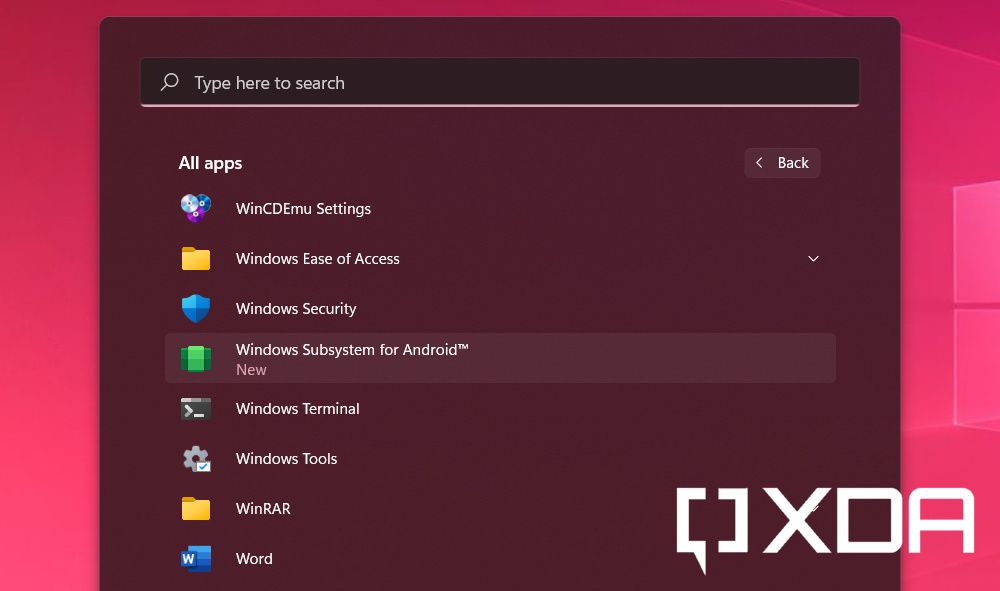It’s been just a day since Microsoft unveiled the long-anticipated Windows Subsystem for Android for Windows 11. The company has also published a plethora of documentation related to the integration with Amazon Appstore and Android app development on Windows using the native Android subsystem. However, unlike typical bleeding edge features, the Dev channel of Windows 11 isn’t officially permitted to access the initial preview for Android apps. For now, not only you’ll need to be enrolled in the Beta channel, but also your PC’s region should be set to the United States. Apart from these “soft” restrictions, you can only run a small set of Android apps published to the Amazon Appstore that are approved by Microsoft and Amazon at this moment.
If you’re on the Stable or Dev channel of Windows 11 and you don’t want to change the update channel just for the sake of running Android apps, then you would be glad to know that the current release of the Windows Subsystem for Android can be easily installed and run on the unsupported builds as well as on legacy platforms without any kind of modifications. It is also possible to sideload Android apps using ADB, which means you can enjoy all the bells and whistles without limiting yourself to the Amazon Appstore offerings.
How to run Android apps on any Windows 11 PC
Step 1 – Grab the installer package of the Windows Subsystem for Android
Just like the Windows Subsystem for Linux (WSL), the Windows Subsystem for Android is also distributed through the Microsoft Store for devices running Windows 11. Since Microsoft doesn’t offer an official way to fetch the direct download link of an app package from its Store, we will opt for a third-party site to pass the hurdle.
- Click here to open the website of Online link generator for Microsoft Store by @rgadguard.
- The product ID of the Windows Subsystem for Android app is 9P3395VX91NR, so you have to put the same in the search box after selecting “ProductId” from the first drop-down menu. Alternatively, you can directly put
https://www.microsoft.com/en-us/p/windows-subsystem-for-android/9p3395vx91nras the “URL (link).” Next, select the channel as “Slow” from the second drop-down menu.

- Locate the largest file from the list. It should be a MSIX Bundle (with the extension .msixbundle) sized a little over 1 GB. This is the main installer package for the Windows Subsystem for Android. Click on the filename to download the file.
- At the time of writing this article, the version number of the Windows Subsystem for Android package is 1.7.32815.0. We’ve also mirrored this particular build for easy-downloading. The SHA-1 hash of the MSIX Bundle for this version is
0c4b3430bcd37be562f54322c79fb14f11ce1348.
- At the time of writing this article, the version number of the Windows Subsystem for Android package is 1.7.32815.0. We’ve also mirrored this particular build for easy-downloading. The SHA-1 hash of the MSIX Bundle for this version is
Step 2 – Install the Windows Subsystem for Android package
A MSIX Bundle is a packaging format that comprises multiple MSIX packages – each of which can support a specific system architecture. This is why you can install the package on both traditional x64 PCs, as well as on compatible ARM64 devices.
- Open Windows Terminal as administrator and start a PowerShell instance. To do so, right click on the Start button and select Windows Terminal (Admin). By default it should open with PowerShell, but if it doesn’t, then invoke a new tab with PowerShell.
- Execute the following command to install the MSIX Bundle you downloaded:
Add-AppxPackage -Path <path_to_msixbundle_file>
- If everything goes right, then the package will be deployed and you’ll see a new icon in your Start Menu.

Step 3 – Sideloading apps on the Windows Subsystem for Android
Now that we’ve installed the Windows Subsystem for Android, it’s time to configure it for app sideloading. To make things easier, we have a separate comprehensive tutorial for sideloading Android apps on Windows 11. Take a look at the guide below:
How to sideload Android apps on Windows 11
The end result should be something like this:

Termux, a popular Android terminal emulator app running under Windows 11
As you can see, the screenshots have been taken on a Windows 11 instance that is running build 22000.258, i.e. the first post-General Availability update. Matter of fact, the model of the CPU is the Intel Core i5-6500T, which is neither officially supported by the Windows Subsystem for Android, nor Windows 11. We haven’t encountered any groundbreaking glitches so far, but your mileage may vary.
Stay tuned to XDA as we cover all the updates and new features related to the Windows Subsystem for Android as they come out!
The post You don’t need to be a Windows Insider to get Android apps on Windows 11 appeared first on xda-developers.
from xda-developers https://ift.tt/2XBo3xa
via IFTTT
No comments:
Post a Comment